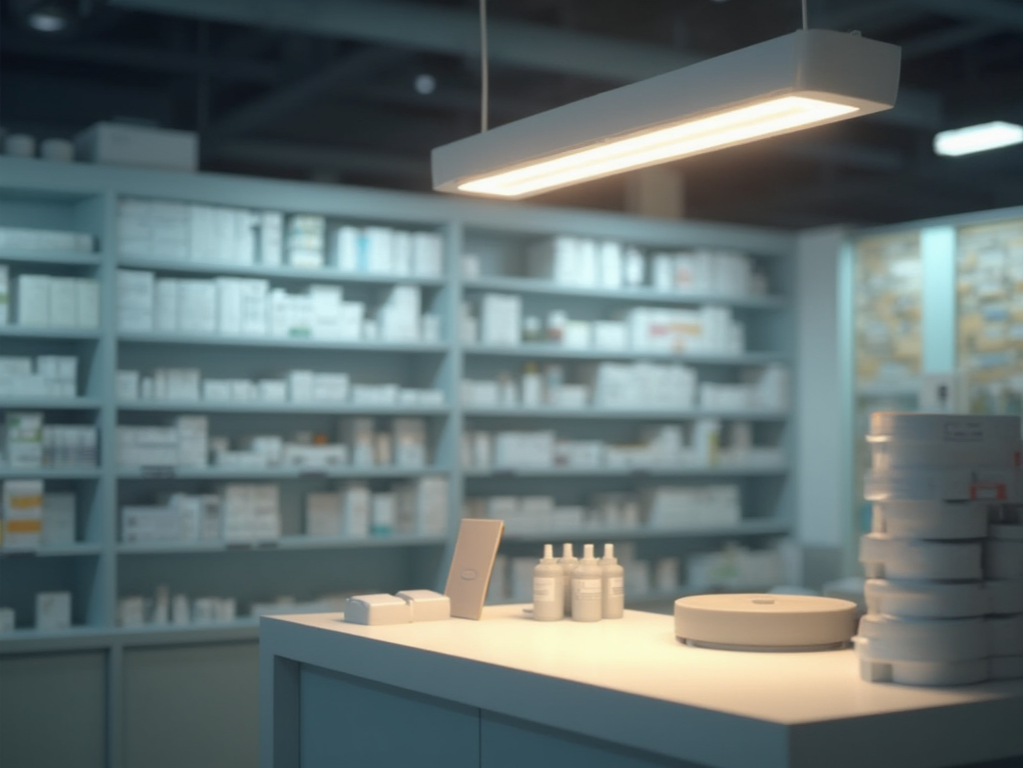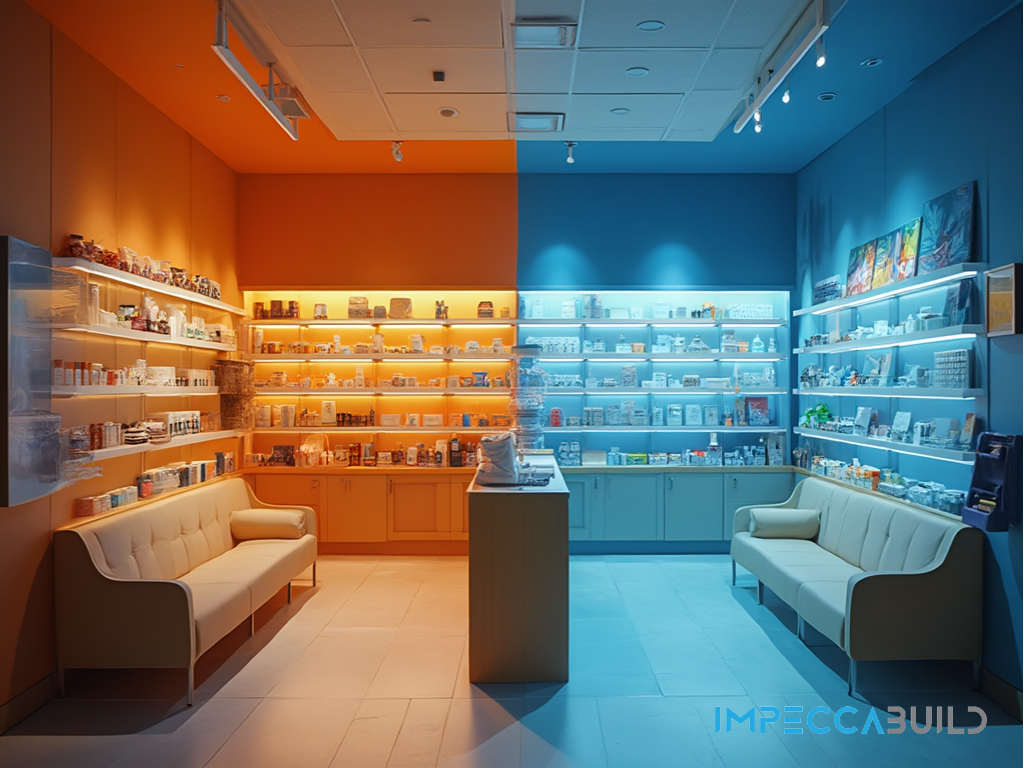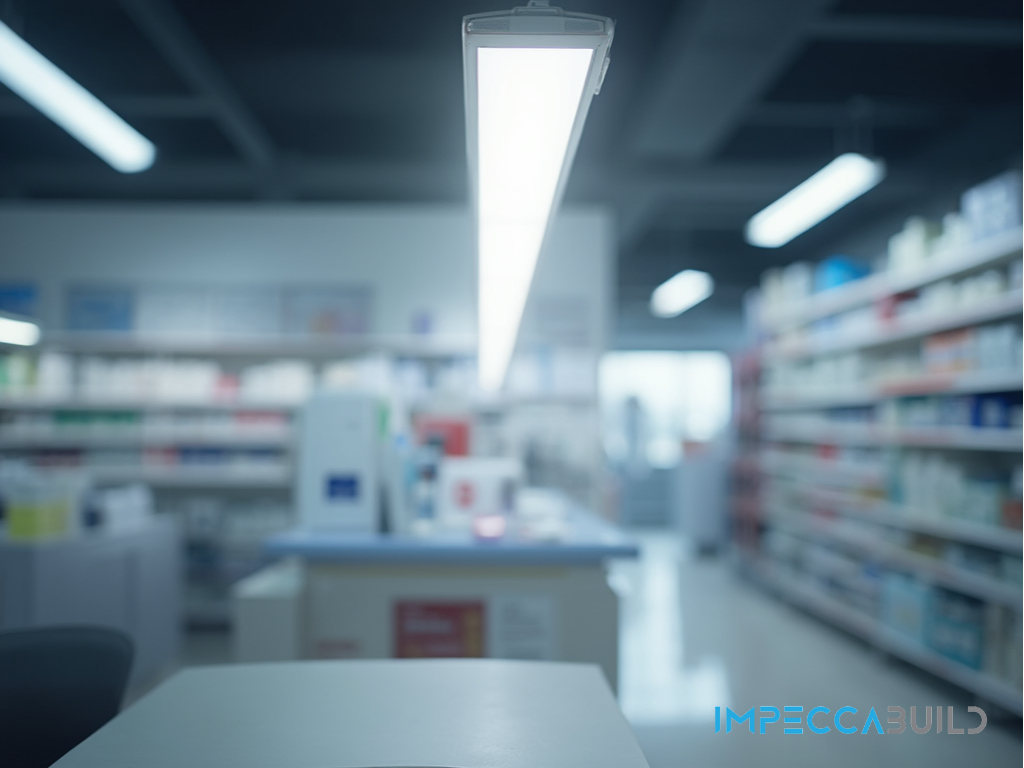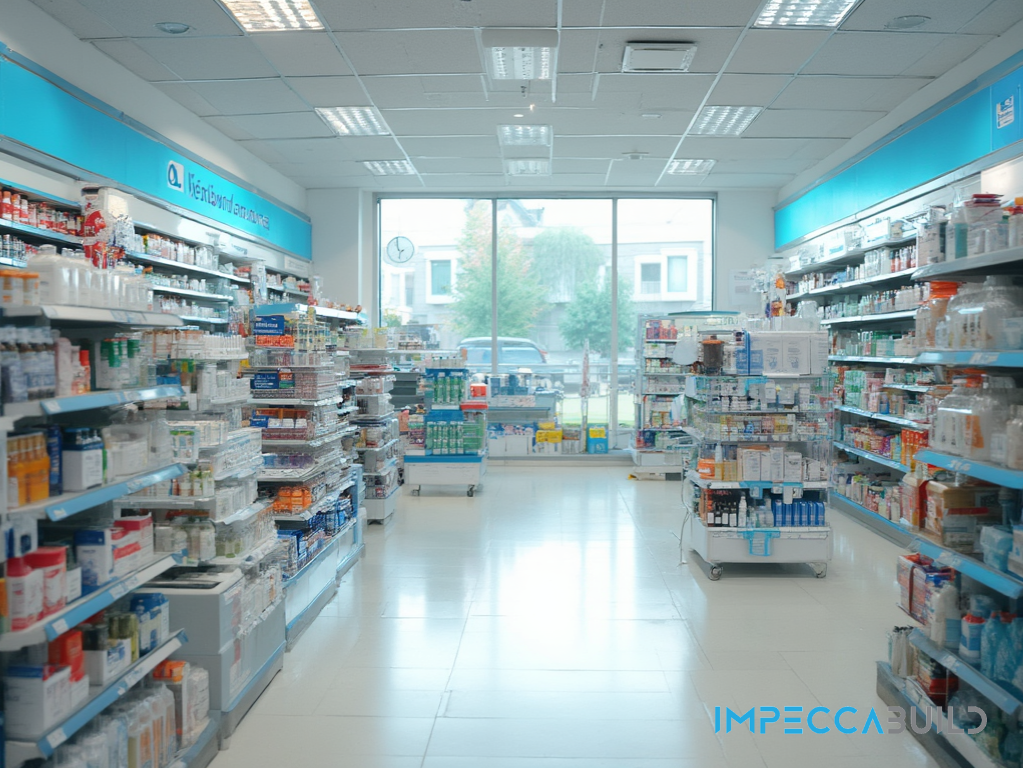Lighting plays a crucial role in shaping the atmosphere and functionality of any space, and pharmacies are no exception. Pharmacy lighting design is more than just illuminating shelves and counters—it’s about creating an environment that is both inviting for customers and efficient for staff. The right lighting can improve workflow, highlight important areas, and create a positive shopping experience for your customers.
In this post, we’ll explore the key aspects of pharmacy lighting design, why it matters, and how it can be optimized to enhance both the mood and functionality of your pharmacy.
The Role of Pharmacy Lighting Design in Customer and Staff Satisfaction
Why Pharmacy Lighting Design Matters
Lighting is one of the most overlooked yet impactful aspects of pharmacy design. Well-planned pharmacy lighting design ensures that customers can easily navigate the space, see products clearly, and feel comfortable during their visit. Poor lighting, on the other hand, can make the environment seem unwelcoming or even cause visual discomfort.
Beyond the customer experience, effective pharmacy lighting design also boosts staff productivity. Proper task lighting in key areas, such as the dispensing counter and consultation rooms, reduces eye strain and enhances focus, allowing staff to perform their duties more efficiently and accurately. When the right balance of ambient, task, and accent lighting is achieved, both customers and employees benefit from an improved experience.
Ultimately, a well-executed lighting plan not only enhances the overall aesthetic but also plays a vital role in defining your pharmacy’s brand and customer perception.

Types of Lighting in Pharmacy Lighting Design
Ambient Lighting in Pharmacy Lighting Design
Ambient lighting serves as the foundation of any well-designed pharmacy. It provides general illumination that fills the entire space, ensuring that customers can see clearly and navigate the area without difficulty. A welcoming atmosphere often starts with the right ambient lighting, as it sets the tone for the entire environment. Too dim, and the space may feel cramped and uninviting; too harsh, and it can create discomfort for both customers and staff.
Ambient lighting serves as the foundation of any well-designed pharmacy. It provides general illumination that fills the entire space, ensuring that customers can see clearly and navigate the area without difficulty. A welcoming atmosphere often starts with the right ambient lighting, as it sets the tone for the entire environment. Too dim, and the space may feel cramped and uninviting; too harsh, and it can create discomfort for both customers and staff.
In pharmacy lighting design, ambient lighting typically comes from overhead fixtures such as LED panels, recessed lights, or ceiling-mounted fixtures that spread light evenly across the room. These solutions ensure consistent brightness throughout the space, creating a pleasant shopping experience for customers while enabling staff to perform their tasks efficiently.

Task Lighting for Precision Work in Pharmacy Lighting Design
Task lighting is essential for work areas in pharmacies, particularly at the dispensing counter, consultation rooms, and prescription preparation areas. These spaces require focused light to enable precise tasks, such as reading labels, filling prescriptions, or consulting with patients. Without proper task lighting, staff can experience eye strain, leading to mistakes or decreased productivity.
In pharmacy lighting design, task lighting is usually achieved through the use of adjustable fixtures like under-cabinet lights, desk lamps, or spotlights that direct light to specific areas. By providing bright, focused light, task lighting ensures that the most critical functions of the pharmacy are carried out with accuracy and ease.
Accent Lighting in Pharmacy Lighting Design
Accent lighting adds an extra layer of sophistication to a pharmacy by highlighting specific areas such as product displays, signage, or promotional zones. While ambient and task lighting focus on overall visibility and functionality, accent lighting serves an aesthetic purpose by drawing attention to key features within the space. It can make products stand out and encourage customers to explore certain sections of the store.
Incorporating accent lighting in pharmacy lighting design can be as simple as using track lights, wall sconces, or LED strip lights to highlight shelving units, signage, or even architectural details. This type of lighting not only enhances the visual appeal of the space but also contributes to the overall customer experience by subtly guiding their attention.
How Pharmacy Lighting Design Influences Mood
Enhancing Mood and Atmosphere with Pharmacy Lighting Design
How Pharmacy Lighting Design Influences Mood
Lighting plays a powerful role in shaping how customers feel when they walk into a pharmacy. The use of warm or cool lighting can have a significant impact on their mood and perception of the space. For example, warmer lighting—such as soft yellow or amber tones—can create a comforting and calming environment, making customers feel more at ease during their visit. This is particularly useful in pharmacies where consultations or health services take place, as a soothing atmosphere can enhance the overall customer experience.
On the other hand, cooler lighting—like bright white or blue tones—can create an energetic and efficient environment, ideal for pharmacies that focus on high-volume customer flow and quick service. In pharmacy lighting design, it’s important to match the lighting tone with the intended customer experience, whether that’s a calm, welcoming space or a bright, efficient one. Choosing the right lighting temperature can make a big difference in customer satisfaction and how they interact with your space.

Balancing Functionality and Aesthetics in Pharmacy Lighting Design
One of the key challenges in pharmacy lighting design is finding the right balance between functionality and aesthetics. While lighting needs to be practical—providing enough brightness for customers and staff to see clearly—it also plays a crucial role in creating an inviting and attractive space. Striking the right balance means that your pharmacy will not only look good but also operate efficiently.
Lighting should reflect your brand’s identity and the atmosphere you want to create. A pharmacy aiming to provide a premium experience might opt for elegant accent lighting that highlights certain product areas, while a budget-conscious pharmacy may prioritize bright, functional lighting to maximize visibility and efficiency. At the same time, it’s essential to avoid overwhelming the space with overly harsh or dim lighting, as this can detract from both the visual appeal and the functionality of the pharmacy.
Pharmacy Lighting Design for Optimal Workflow
Supporting Staff Efficiency with Pharmacy Lighting Design
Lighting plays a critical role in maintaining an efficient workflow within a pharmacy. Well-placed lighting in key areas such as dispensing counters, storage areas, and consultation rooms ensures that staff can work accurately and efficiently. Proper task lighting in these areas helps reduce errors by providing clear visibility during tasks like medication dispensing and inventory management.

Incorporating the right lighting layout as part of pharmacy lighting design ensures that staff are equipped with bright, focused light where they need it most, improving workflow and minimizing disruptions. In high-traffic areas, ample lighting helps to keep processes moving smoothly, ensuring that both customers and staff have a seamless experience.
Reducing Fatigue and Enhancing Focus with Effective Lighting
Lighting isn’t just about visibility—it has a direct impact on staff well-being. Bright, effective task lighting can significantly reduce eye strain and fatigue, particularly for staff working long shifts or handling detailed tasks. In pharmacies, where precision and accuracy are critical, proper lighting ensures that staff can maintain focus throughout the day, leading to fewer mistakes and higher productivity.
By integrating ergonomic lighting solutions, pharmacy lighting design supports staff performance, creating a more comfortable and functional workspace. This focus on staff well-being ultimately leads to better customer service and smoother pharmacy operations.
Best Practices for Pharmacy Lighting Design
Using Energy-Efficient Solutions in Pharmacy Lighting Design
In modern pharmacy fit-outs, energy efficiency is a top priority. By using energy-efficient lighting solutions such as LED lights, pharmacies can significantly reduce their energy consumption and operational costs. LED lights, in particular, are an excellent choice due to their long lifespan and low heat emission. Unlike traditional lighting, LEDs consume far less power while providing the same, if not better, illumination.
Incorporating energy-efficient lighting into your pharmacy lighting design not only saves on monthly energy bills but also aligns with sustainability goals—a growing priority for many businesses. By making this environmentally-friendly choice, pharmacies can contribute to a greener future while enjoying long-term cost savings.

Maximizing Natural Light in Pharmacy Lighting Design
Maximizing natural light is a smart way to enhance both the functionality and ambiance of a pharmacy. Natural light can create a more welcoming and pleasant environment, making the space feel brighter and more open. It also offers the added benefit of reducing the need for artificial lighting during the day, leading to lower energy consumption.
There are several ways to incorporate natural light into your pharmacy lighting design. For example, strategically placing windows, skylights, or reflective surfaces can amplify the available sunlight, ensuring it reaches deeper into the pharmacy. This not only enhances the customer experience but also creates a more comfortable environment for staff working long hours indoors.

Balancing Aesthetics and Functionality in Pharmacy Lighting Design
Striking the right balance between aesthetics and functionality is key to effective pharmacy lighting design. While the primary role of lighting is to ensure visibility and efficiency, it also plays a significant role in the overall look and feel of the pharmacy. A well-designed lighting scheme can create an inviting and professional atmosphere that aligns with your pharmacy’s brand image.
To achieve this balance, lighting must be strategically placed to enhance both the ambiance and the operational efficiency of the space. This might include using accent lighting to highlight products or signage while ensuring task lighting is sufficient for staff performing detailed work. When aesthetics and functionality come together, the result is a pharmacy that looks great and operates smoothly.
Final Thoughts on Pharmacy Lighting Design and Its Impact
Conclusion: Why Effective Pharmacy Lighting Design Is Essential
Effective pharmacy lighting design is about more than just illuminating a space—it directly affects the overall atmosphere, customer satisfaction, and staff productivity. Whether it’s creating a welcoming environment for customers or ensuring that staff can work efficiently, the right lighting plays a pivotal role in your pharmacy’s success. By carefully selecting and balancing ambient, task, and accent lighting, you can enhance both the mood and functionality of your pharmacy.

From energy-efficient solutions to maximizing natural light, implementing the best lighting practices ensures that your space is not only aesthetically pleasing but also operationally efficient. At ImpeccaBuild, we understand the intricacies of pharmacy lighting design and are here to help you create a space that works for your business.
Improve Your Pharmacy Lighting Design with ImpeccaBuild
Ready to transform your pharmacy with optimized lighting design? At ImpeccaBuild, we specialize in creating functional, beautiful spaces that enhance both customer experience and staff workflow. Contact us today at 1300 LET’S BUILD or visit our Pharmacy Fit-Out page to see how we can bring your vision to life.
FAQ Pharmacy Lighting Design
Frequently Asked Questions
1. Why is pharmacy lighting design important?
Pharmacy lighting design plays a critical role in creating a welcoming environment for customers while ensuring staff productivity. Effective lighting helps customers navigate the space easily, enhances product visibility, and reduces eye strain for staff during detailed tasks.
2. What are the types of lighting used in pharmacy design?
Pharmacy lighting typically includes three types: ambient lighting for overall illumination, task lighting for focused work areas, and accent lighting to highlight displays or important zones within the pharmacy.
3. How does pharmacy lighting influence mood?
Lighting can have a significant impact on customer mood. Warm lighting creates a calm and comforting atmosphere, while cool lighting generates an efficient and energetic environment, influencing how customers feel during their visit.
4. How can proper lighting improve pharmacy workflow?
Proper lighting in workspaces like dispensing counters and consultation rooms helps reduce errors and eye strain, allowing staff to work more efficiently and with greater accuracy.
5. What are the best lighting solutions for pharmacies?
Energy-efficient LED lighting, natural light integration, and a balance between aesthetics and functionality are the best lighting solutions for pharmacies. These solutions enhance both customer experience and staff performance.
6. How can natural light be incorporated into pharmacy lighting design?
Natural light can be integrated through windows, skylights, and reflective surfaces. This not only creates a more pleasant environment but also reduces reliance on artificial lighting, thereby lowering energy costs.
7. What are the benefits of energy-efficient lighting in pharmacies?
Energy-efficient lighting, such as LED fixtures, offers lower energy consumption, longer lifespan, and reduced operational costs. It also aligns with sustainability goals, making it a cost-effective and eco-friendly option for pharmacies.
8. How does pharmacy lighting balance aesthetics with functionality?
Balancing aesthetics and functionality in pharmacy lighting involves using accent lights for product displays and general lighting for visibility, all while ensuring the space remains inviting for customers and efficient for staff operations.
{ “@context”: “https://schema.org”, “@type”: “FAQPage”, “mainEntity”: [ { “@type”: “Question”, “name”: “Why is pharmacy lighting design important?”, “acceptedAnswer”: { “@type”: “Answer”, “text”: “Pharmacy lighting design plays a critical role in creating a welcoming environment for customers while ensuring staff productivity. Effective lighting helps customers navigate the space easily, enhances product visibility, and reduces eye strain for staff during detailed tasks.” } }, { “@type”: “Question”, “name”: “What are the types of lighting used in pharmacy design?”, “acceptedAnswer”: { “@type”: “Answer”, “text”: “Pharmacy lighting typically includes three types: ambient lighting for overall illumination, task lighting for focused work areas, and accent lighting to highlight displays or important zones within the pharmacy.” } }, { “@type”: “Question”, “name”: “How does pharmacy lighting influence mood?”, “acceptedAnswer”: { “@type”: “Answer”, “text”: “Lighting can have a significant impact on customer mood. Warm lighting creates a calm and comforting atmosphere, while cool lighting generates an efficient and energetic environment, influencing how customers feel during their visit.” } }, { “@type”: “Question”, “name”: “How can proper lighting improve pharmacy workflow?”, “acceptedAnswer”: { “@type”: “Answer”, “text”: “Proper lighting in workspaces like dispensing counters and consultation rooms helps reduce errors and eye strain, allowing staff to work more efficiently and with greater accuracy.” } }, { “@type”: “Question”, “name”: “What are the best lighting solutions for pharmacies?”, “acceptedAnswer”: { “@typeYou Might Also like:
If you enjoyed reading this blog, you may also be interested in:
- 6 Hidden Risks Of Buying Without A Pre-Purchase Inspection
- Pre-Purchase Building Inspection Cost Sydney: 6 Ways To Save
- Residential Pre-Purchase Inspections: 10 Powerful Benefits
- Local Cafe Fitout Expert Sydney: 6 Smart Reasons to Choose Local
- Choosing a Cafe Fitout Company Sydney: 5 Expert Tips for Success
- Cafe Fitout Costs Sydney 2024: Simple Tips for Maximum Savings
- Location Impact on Pharmacy Fit-Out Costs: 6 Shocking Truths
- Pharmacy Location Rules for New Pharmacies: 8 Approval Insights
- Reducing Pharmacy Fit-Out Costs: 5 Powerful Ways to Save Big
- 7 Critical Questions to Ask a Pharmacy Fit-Out Company Before Hiring
